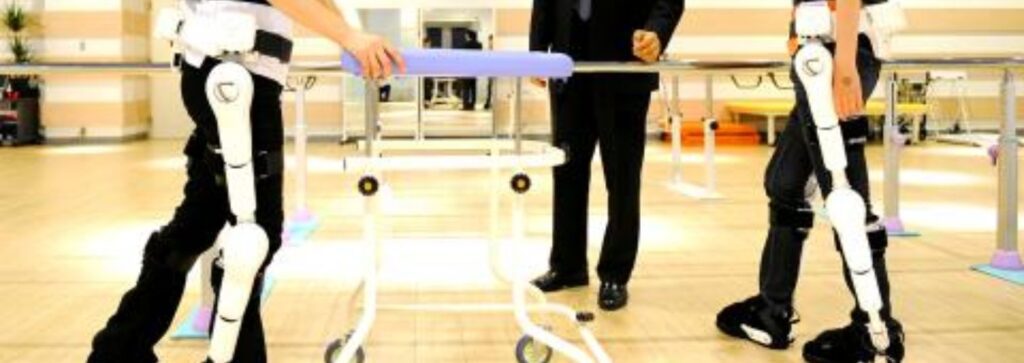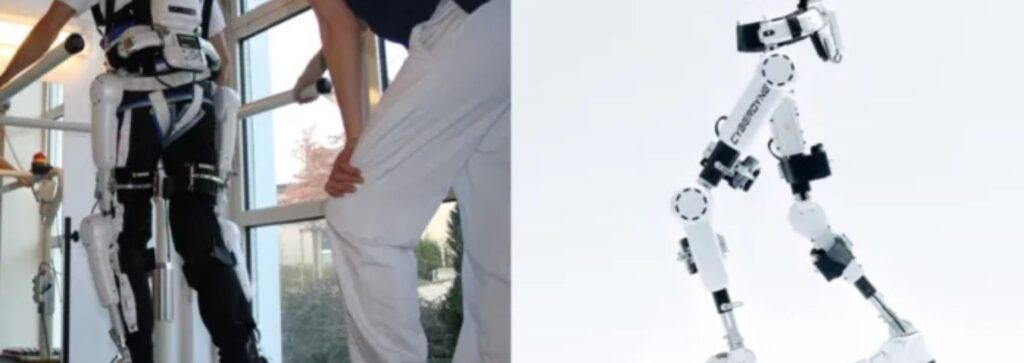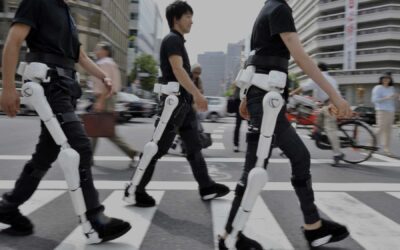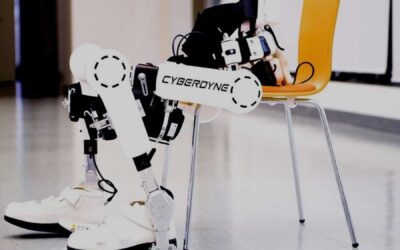The Hybrid Assistive Limb is a wearable robot suit that assists in voluntary control of the knee and hip joint motion. The HAL detects the bioelectric signals generated by patients’ muscle activities and force-pressure signals caused by patients’ weight shifts.
Cyberdyne treatment with wearable cyborg Hybrid Assistive Limb (HAL) improves ambulatory function in patients with slowly progressive rare neuromuscular diseases.
Benefits of HAL

Cybernics Treatment uses HAL to regenerate the function of the wearer. The treatment targets spinal cord injury, stroke, and neuromuscular diseases.
When a person tries to move the body, a signal is transmitted from the brain to the muscles through the nerves according to the intention of movement, and at that time, weak bioelectric potential signals leak to the body’s surface. HAL detects the wearer’s bioelectric potential signal with a sensor attached to the skin and realises the action. The brain sends nerve impulses to the leg muscle and the sensors on the patient’s skin register these impulses.
The key to promoting functional improvement through Cybernics treatment is not just transmitting voluntary command signals from the human brain to the musculoskeletal system via the spinal cord and peripheral nerves, but more so on the return of feedback from the sensation of actual movement to the human brain.
The functional improvement/regeneration technology using the “Wearable Cyborg™ is an innovative treatment technology that enables the improvement of human brain-nerve-musculoskeletal functions by activating the body’s self-healing ability that humans are naturally in possession of.
HAL’S Motion Principle
The robotic suit – HAL- uses the patient’s intention to move the limbs:
- Command signals are generated
The brain generates and transmits signals to muscles necessary for motions through nerves.
- Receiving the signals, the muscle move
The muscle contacts to generate power when it receives the appropriate command signal sent from the brain through the nerves.
- HAL Reads Signals
Signals sent to muscles by the brain leak on the skin surface as very faint signals, so-called bio-electric signals.
- HAL Moves as The Wearer Intends
HAL controls the power units at each joint based on these bio-electrical signals [BES] and allows the wearer to perform the desired movements with their voluntary commands.
- The Brain Learns Motions
When HAL has appropriately assisted the intended movement, the feeling is fed back to the brain. Active use of these neural pathways for voluntary movement with physical feedback to the brain leads to an improved ability for the wearer to walk on their own.
Recovery

Rehabilitation robots in physical therapy are suggested to have extensive application prospects. Top rehabilitation clinics trust our sensing technology to achieve rehabilitation breakthroughs every day. Discover how you can utilise ‘Cyberdyne technology’ to achieve the same.
Rehabilitation robots in physical therapy are effective as they increase the number of times patients perform a given exercise
Our Patient – Anderson’s Storey
I was lifting my legs with my hips while walking and not my knees. After 3 months of intense therapy at Cyberdyne in Bochum, I started walking by lifting my knees. I can now walk for longer periods because my walking method has improved. Before going to Cyberdyne, I was walking 10 metres in almost 4 minutes but now it takes me around 50 seconds.
The “Wearable Cyborg™ uses brain waves to let people walk by improving ambulatory function in patients.
Log onto https://rehabmodalities.com/ for more info on our neuro-robotic rehabilitation technology that benefits patients.



